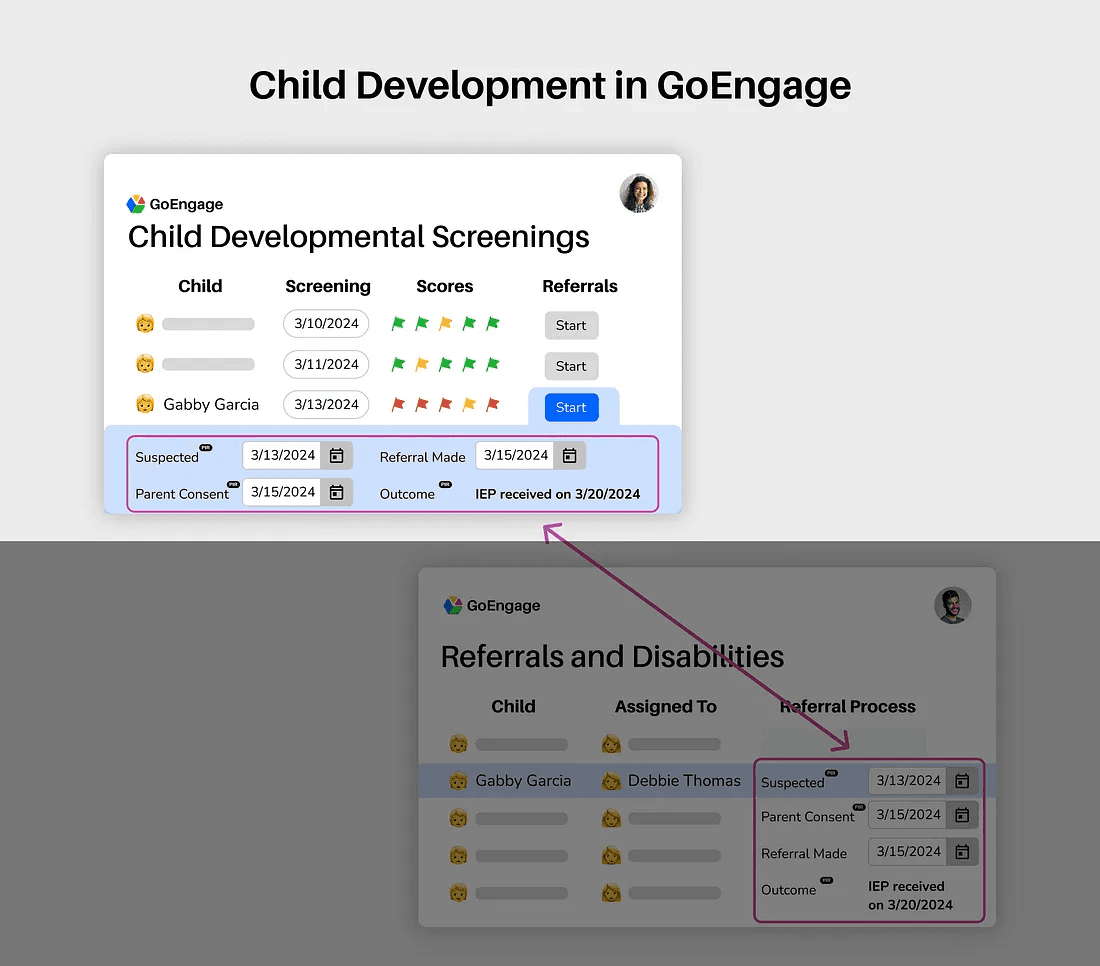For Head Start beginners: Child development overview
All new employees at GoEngage are required to undergo a rigorous Head Start Bootcamp in order to best serve agencies. We recently updated the Child Development & Education course and realized it could also be a useful guide for any Head Start staff just starting out. So, here’s an excerpt!
Summary
This chapter covers the basics of child development, as well as the full screening and referral process.
Head Start Staff
Generally, agency staff with the role 🧑 Education Manager/Coordinator, 🧑 Disabilities Manager/Coordinator, or 🧑 Child Development Manager oversee the child development component of a Head Start agency’s operations.
Child Development Domains
When your Head Start agency says “child development,” they are referring to the 👣 physical, 🧠 cognitive, 🗣️ social, and 💕 emotional growth and development of young children from birth to age 5.
A child’s growth and development is measured with 5–7 different domains (some domains don’t apply to infants):
Physical Development — Subdomains: Fine motor skills, gross motor skills
Cognitive — Subdomains: Recognition, perception
Language and literacy
Learning
Social Emotional
Child Development Screening
Head Start Program Performance Standards (HSPPS) Requirement
HSPPS 1302.33 requires your agency to complete a child developmental screening within 45 calendar days of “when the child first attends the program or, for the home-based program option, receives a home visit.”
Screening Instruments
An instrument is what your Head Start agency uses to screen children. Think of an instrument as an assessment/scoring rubric. ASQ-3 (Ages and Stages) is the most popular instrument for child development screenings.
Instruments are organized by age range. Different ages use different questionnaires, and different ages have different cutoff scores.
Questionnaires
A questionnaire is like an interview.
Usually, there are two questionnaire versions:
The parent version is in a “take-home” format. The teacher gives it to the parent, who completes it and returns it.
The teacher version is completed by the teacher, though they will need clarification from parents to answer some questions (e.g. how many hours does the child sleep?).
Responses are recorded as scores based on the child’s “performance” on the question. For each domain, a total score is calculated.
In GoEngage, children will receive colored flags based on the total score for each domain:
🟢 flag: All good. No concerns.
🟡 flag: Borderline. Keep an eye on this child
🔴 flag: Concern. Consider starting the referral process.

GoEngage syncs data across all processes, to encourage high-quality data and a collaborative environment.
Referral Process
The referral process is used to create a specialized plan for a child who has been identified as having developmental issues. The plan is used to ensure that the child won’t fall behind due to their identified developmental issue.
The referral process usually follows this pattern:
The agency sends an external referral to certified child development experts within the LEA, or Local Education Agency, typically a nearby public school system.
The LEA schedules time to observe the child and perform any other necessary steps to develop an accurate understanding of the child’s needs. Usually, agencies don’t need to keep track of what happens during this step.
The agency receives an IEP or IFSP from the LEA.
A teacher meets with the LEA about the plan. Sometimes, the parent is present too.
An IEP (Individualized Education Plan) is for children 3–5 years old, and has a 12-month renewal period.
An IFSP (Integrated Family Service Plan) is for children 0–3 years old. It’s called a “family” plan because the child is too young for “education” to come into play, and development requires support from the family. It has a 6-month renewal period because the child is growing fast.

GoEngage syncs data across all processes, to encourage high-quality data and a collaborative environment.
IFSP/IEP Renewal Process
The renewal process is simple:
The IFSP/IEP is sent, preferably to the same experts who initially created the plan.
The LEA performs the same process as before, meeting both child and parent, observing the child, etc.
The agency receives a response: renewed, or no longer qualified.
💡 Tip for GoEngage users: Scan your Referrals and Disabilities task for red or yellow plans.

Thanks for reading!
We are very passionate about our work with Head Start agencies, and we’re happy you’re here. Feel free to comment any questions!
Sign up for our weekly newsletter, which includes:
☕Your morning cup o’ Head Start: The news shaping your agency every week
🙆♀️Head Start Life Hacks: Helpful tips and tricks we collect from our amazing GoEngage users
Curious about GoEngage?
Book a free product demo: GoEngage.app/demo
Send us an email: sales@GoEngage.app

Michael Ma: Visionary CEO/CTO of Cleverex Systems
Michael Ma is the CEO and CTO of Cleverex Systems, the creator of GoEngage, where he combines strategic leadership with cutting-edge technology to deliver innovative solutions for Head Start programs nationwide. With a deep understanding of software development and a passion for creating impactful tools, Michael has spearheaded the evolution of GoEngage into a comprehensive platform that streamlines operations and empowers agencies to better serve children and families.
Under Michael’s leadership, Cleverex Systems has become a trusted partner for Head Start programs, known for its agility, user-centric design, and unwavering commitment to excellence. His ability to merge technical expertise with a forward-thinking vision continues to drive meaningful change in early childhood education and program management.





